There are castles and then there are chateau castles and France is the winner in this category. The Château de la Mothe-Chandeniers is a castle located in the west-central part of France. The castle was originally built during the Middle Ages and changed hands a number of times during its long and colorful history. A number of illustrious French families, including the Lejeune and the Maupéou families, are associated with the Château de la Mothe-Chandeniers through their ownership of the castle. In 2017, money was raised via crowdfunding for the purchase and restoration of the castle. As a result, the castle is today owned by over 18000 people around the world.
The Château de la Mothe-Chandeniers is located in the commune of Les Trois-Moutiers in the French region of Nouvelle-Aquitaine. The castle dates to the 13th century AD and was constructed by the Bauçay (also spelled as Beauçay or Baussay) family. Therefore, at that point in time, the castle was known as La Mothe de Bauçay. The castle acquired its current name during the 15 th century AD. Around the middle of that century, La Mothe de Bauçay was owned by the Chaunay family, who were also in possession of Javarzay, another castle, and Champdeniers.
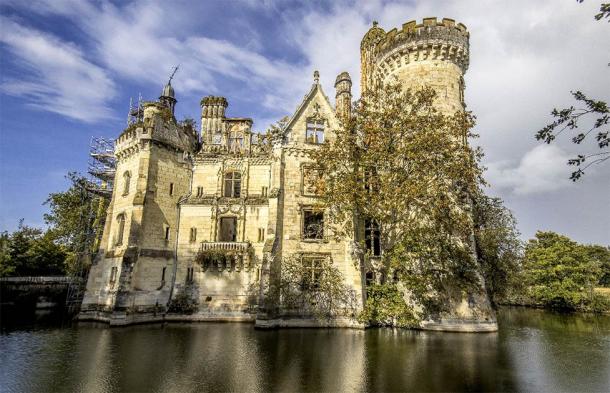
September 22, 2019 AD view of the ruins of the Château de la Mothe-Chandeniers during Heritage Days. ( Romain TALON / Adobe Stock)
Through his marriage to Anne de Chaunay these three domains were acquired by Jean de Rochechouart. These domains were later inherited by the couple’s eldest son, François. Incidentally, Champdeniers became Chandeniers, and the branch of the family established by Anne and Jean adopted the surname Rochechouart-Chandenier. Therefore, from the 15 th century AD onwards, the castle was referred as La Mothe Chandeniers. At the same time, however, its old name was used occasionally. It was only from 1624 onwards that the name “La Mothe de Bauçay” ceased to be used permanently.
The Early History Of The Château de la Mothe-Chandeniers
According to Léo Desaivre, a regional historian from Chandeniers, the castle saw action during the Hundred Years’ War . Although Desaivre does not mention any specific battles or sieges that the Château de la Mothe-Chandeniers was part of, he notes that the castle was taken by the English on several occasions.
In the subsequent centuries, the castle led a quiet existence, though it was severely damaged during the French Revolution . Apart from that, the only significant incidents in the castle’s history were the transfers of ownership. For instance, the Rochechouart-Chandenier family retained control of the Château de la Mothe-Chandeniers until 1685 AD, when they sold the castle off. Incidentally, the family also sold off the lordship of Champdeniers, which they held until 1668 AD. In 1809 AD, the Château de la Mothe-Chandeniers was purchased by François Hennecart from the Maupéou family.
The Maupéous were a significant aristocratic family in France during the 18 th century AD. The family’s most prominent member was René Nicolas Charles Augustin de Maupeou, who served as the chancellor of France during the reign of Louis XV . Born on the 25 th of February 1714 AD, René Nicolas was the eldest son of René Charles de Maupéou. René Charles was trained in law, and in 1763 AD, became the president of the parlement (the high court of justice) of Paris. In 1768, René Charles was appointed as chancellor of France. Within 24 hours of assuming the chancellorship, however, René Charles resigned, and his son was appointed chancellor in his place.
René Nicolas best-known for his success in depriving the parlements of their political powers, which they had used to block the reforms proposed by the ministers of Louis XV. René Nicolas’ success, however, was short-lived: it only lasted three years. Louis XV died in 1774, and his successor, Louis XVI , restored the parlements to their former powers and privileges, whilst René Nicolas was forced into retirement. This had dire consequences for the French monarchy , as Louis XIV lost the opportunity to institute fundamental reforms that might have prevented outbreak of the French Revolution.
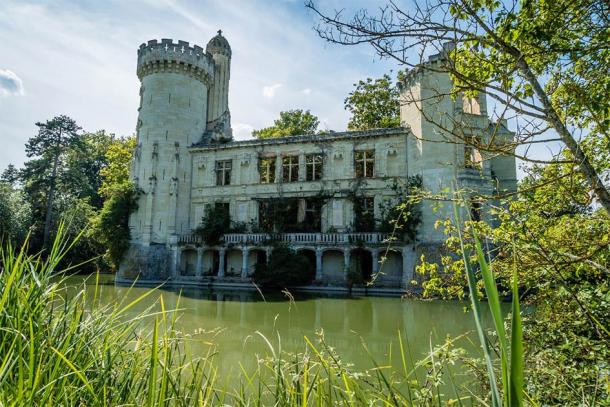
A classic view of the water-encircled Château de la Mothe-Chandeniers in France. Source: Stephane Debove / Adobe Stock.
The Chateau’s History After The French Revolution
As for François Hennecart, who bought the castle in 1809 AD, he came from a less aristocratic family compared to the previous owner René Nicolas. François’s father was François Hyacinth Hennecart, a merchant, as was his grandfather Daniel Jacques Hennecart. François himself was a successful entrepreneur, and his great wealth enabled him to purchase the Château de la Mothe-Chandeniers from the Maupéou family.
As the castle had been badly damaged during the French Revolution, its new owner carried out restorations on the structure. In addition, François beautified his property by digging canals on each side of the castle. The one on the back of the castle was a sort of “grand canal” with a pathway and overhanging vines. After François’ death in 1845 AD, the Château de la Mothe-Chandeniers was inherited by his daughter Alexandrine Hennecart. For one reason or another, Alexandrine did not pass the castle down to her eldest daughter Augustine Ardoin. Instead, it went to her younger daughter Marie Ardoin.
In 1857 AD, Marie married Joseph Désiré Edgard Lejeune, who was quite well connected. Joseph was a baron d’Empire and a squire of Napoleon III . Additionally, Joseph was connected to Bernardine Eugénie Désirée Clary, the queen consort of Sweden and Norway, through his mother Louise Clary. Joseph’s maternal grandfather, Etienne François Clary, was a half-brother of the queen. Joseph’s father, on the other hand, was Louis-François Lejeune, a famous general whose long and colorful career is recounted here.
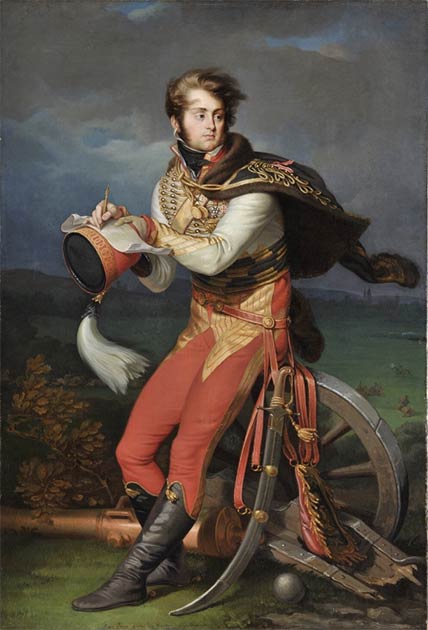
Louis-François Lejeune the famous military man and painter who owned the chateau. (After Jean-Urbain Guérin / Public domain )
The Tale Of Louis-François Lejeune: Military Man And Painter
Louis-François was born in 1775 AD, and for much of his career he served as the aide-de-camp to Louis-Alexandre Berthier, a maréchal d’Empire who served as Napoleon’s Minister of War and chief of staff. Louis-François began his military career in August 1792 AD, when he became a soldier in the Compagnie des arts de Paris. In the years that followed, Louis-François participated actively in the campaigns of the first French Republic and rose quickly through the ranks.
In the same year that he began his military career, for instance, Louis-François was promoted to sous-lieutenant, and in the following year he was promoted again to the rank of lieutenant in the staff of the Army of the North. In 1794 AD, he joined the Army of the Sambre and Meuse, and was at the Siege of Quesnoy, where he was wounded by a piece of wood that hit him in the chest following an explosion. Soon after, he became the aide-de-camp of General Jacob. In 1795 AD, Louis-François was transferred to the engineers corps. Amongst other things, he supervised the building of three bridges over the Rednitz River, and fortified the town of Jülich, which is now in the German state of North Rhine-Westphalia.
In 1800, Louis-François was promoted to the rank of captain and began his service as the aide-de-camp to General Berthier. In 1804 AD, Napoleon was crowned Emperor of the French, and Louis-François continued to serve the new regime in his capacity as Berthier’s aid-de-camp. During the campaigns in Prussia (1806 AD) and Poland (1807 AD), Louis-François served under Berthier. Additionally, he participated in the Siege of Danzig in 1807 AD.
A year later, Louis-François was sent to Spain, where the Peninsular War had broken out. He participated in the Siege of Zaragoza and was wounded twice: once during the assault on the San Augustin Convent, and another time during the assault on Abbey of Santa Engracia. Louis-François’ valiant conduct at Zaragoza earned him the rank of colonel, and in the following year he was back in the service of Berthier for the Danube campaign of 1809 AD. In that year, Louis-François took part in the Battle of Aspern-Essling and the Battle of Wagram and was made a Knight of Saint Leopold of Hungary. In 1810 AD, he became a baron d’Empire .
Louis-François was then given a mission to carry out in Spain, and therefore returned to that country in 1811 AD. In April of that year, whilst they were near Toledo, Louis-François and his dragoon escorts were ambushed by Spanish guerrillas. The dragoons fought to the death, the colonel’s horse received 30 blows and was killed. Louis-François himself was wounded and knocked to the ground. As the guerrillas surrounded the wounded Frenchman, they tried to finish him off by firing at his chest.
In his own memoirs, the colonel claimed that each time the guerrillas pulled the triggers of their muskets, they misfired. Although Louis-François was wounded and believed he was on the brink of death, he did not give up fighting. Instead, he retaliated by seizing the barrel of one of the guerrilla’s muskets and tried to fight them off. Eventually, the leader of the guerrillas arrived, and recognizing that Louis-François was a colonel, ordered his men not to kill him, but to take him as a prisoner.
Subsequently, Louis-François was taken to a place where several other French prisoners were held. When the guerrillas were about to move, they received reports that two of their fellow guerrillas were hanged by a French general. The guerrillas wanted revenge and were preparing to hang Louis-François and the other prisoners. The guerrillas, however, heard gunshots in the distance, and went to investigate. They came upon an unfortunate French courier and his escort, who were slaughtered. As the guerrillas had avenged their executed comrades, the prisoners were spared. As a high-ranking prisoner, Louis-François was first taken to Cadiz, then to Portugal, and finally to England, where he remained for a short time before managing to escape. The colonel returned to France and was once again in the service of Berthier for the 1812 AD campaign against Russia.
After the Battle of Borodino, Louis-François was made the chief of staff to Louis-Nicolas d’Avout, who was commanding the I Corps, and a few weeks later, was promoted to général de brigade . When the French were retreating from Russia, Louis-François suffered from severe frostbite on his face and left the army in December 1812 AD without authorization to recover in France. As a consequence, in February the following year, he was arrested and imprisoned, but was released several weeks later. In May, Louis-François was back in the army, and participated in several battles. At the Battle of Hanau, Louis-François was badly wounded, having been hit in the forehead by a piece of an exploding shell. As a result, his military career ended, and he received a pension after retiring.
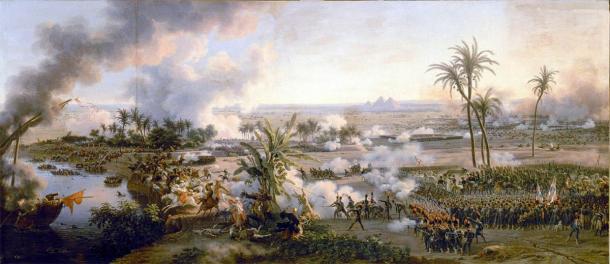
General view of the Battle of the Pyramids, July 21, 1798; campaign in Egypt (1798-1801 AD); painted by Louis-François Lejeune. (Louis-François, Baron Lejeune / Public domain )
In 1821, Louis-François married Louis Clary, and Joseph their son was born five years later. Louis-François dedicated the rest of his life to art, in particular painting, and became the director of the School of Fine Arts in Toulouse in 1837 AD. Louis-François died of a heart attack 11 years later.
From Joseph Lejeune To The Recent Crowdfunding Success
The life of Joseph Lejeune is not as well recorded as his father’s. Nevertheless, it is recorded that Joseph carried out a massive renovation of the Château de la Mothe-Chandeniers around 1870 AD, which completely transformed the monument into a “fairy tale castle.” The inspiration behind this renovation is said to have been Ludwig II of Bavaria, best-known as the person responsible for the construction of the world-famous Neuschwanstein Castle . Joseph is also said to have hosted extravagant parties at the Château de la Mothe-Chandeniers.
The historical record is mostly silent about the fate of the castle in the decades that followed. It is known, however, that in 1932 AD a massive fire broke out, shortly after central heating was installed in the building, and much of the castle was destroyed in the conflagration. Subsequently, the castle was abandoned, forgotten, and was slowly reclaimed by nature.
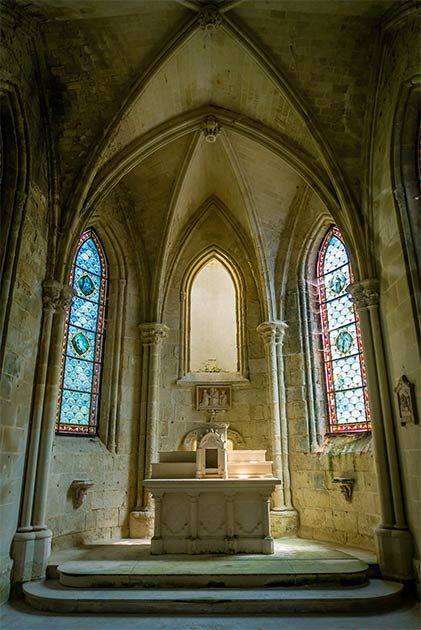
The old Chapel of the Château de la Mothe-Chandeniers. ( Stephane Debove / Adobe Stock)
In 1963 AD, the Château de la Mothe-Chandeniers, along with the surrounding estate, was purchased by Jules Cavroy, a retired industrialist, who intended to turn the area into a farm. The castle was then acquired in 1981 AD by Marc Deyemer, a former secondary school math teacher, who was hoping to restore it to its former beauty. Deyemer, however, was unable to halt nature’s reclamation of the castle, and, despite his best efforts, failed to restore the castle. At one point, he was even tempted to declare the castle a ruin, so that it could be destroyed.
Finally, the castle received the funds it needed in 2017 AD. In December of that year, a project was created by Dartangnans and Adopte Un Château to raise funds to purchase and restore the castle. Over 18000 donors from across the world contributed at least 50 euros (59 dollars) each, and a total of 1.6 million euros (1.86 million dollars) was raised.
Apart from saving the Château de la Mothe-Chandeniers, the 18000 donors are now the co-owners of the castle as well. Thanks to these donations, the Château de la Mothe-Chandeniers was brought back from the brink of destruction and is no longer a forgotten monument.
Top image: An aerial view of Château de la Mothe-Chandeniers. Source: Pierre Mairé / CC BY-SA 3.0
By Wu Mingren
References
Base collaborative Pierfit, 2020. François Hennecart. [Online]
Available at: https://gw.geneanet.org/pierfit?lang=fr&n=hennecart&oc=0&p=francois+fidele
Base collaborative Pierfit, 2020. Joseph Désiré Edgard Lejeune. [Online]
Available at: https://gw.geneanet.org/pierfit?lang=fr&p=joseph+desire+edgard&n=lejeune
Dartagnans, 2020. Et Si On Adoptait La Mothe Chandeniers. [Online]
Available at: https://dartagnans.fr/en/projects/et-si-on-adoptait-un-chateau/campaign
Desaivre, L., 1904. Inventaire du Mobilier du Chateau de la Mothe-Chandenier en 1530. [Online]
Available at: https://gallica.bnf.fr/ark:/12148/bpt6k578947q/f605.image.r=%22mothe-chandenier%22
FaithTap Staff, 2015. Castle Was Abandoned After A Fire 80 Years Ago, The Inside Is Hauntingly Beauiful. [Online]
Available at: https://web.archive.org/web/20161227125735/http://www.faithtap.com/4852/internet-group-attempts-to-rescue-historic-french-castle/
Hemming, O., 2017. Château-de-la-Mothe-Chandeniers – Saving History. [Online]
Available at: https://www.oliverhemming.com/chateau-de-la-mothe-chandeniers-saving-history/
Jensen, N. D., 2014. General Louis-François Lejeune. [Online]
Available at: https://www.frenchempire.net/biographies/lejeune/
Maloney, M., 2017. Over 11,000 Strangers Just Bought an Abandoned French Castle Together. [Online]
Available at: https://www.townandcountrymag.com/leisure/travel-guide/a14390720/chateau-de-la-mothe-chandeniers-purchased/
mothe-chandeniers.com, 2020. Château de la Mothe Chandeniers. [Online]
Available at: https://mothe-chandeniers.com/fr/
The Editors of Encyclopaedia Britannica, 2020. René-Nicolas-Charles-Augustin de Maupeou. [Online]
Available at: https://www.britannica.com/biography/Rene-Nicolas-Charles-Augustin-de-Maupeou
Willsher, K., 2017. La Mothe-Chandeniers – the French chateau now with 7,400 owners. [Online]
Available at: https://www.theguardian.com/world/2017/dec/05/la-mothe-chandeniers-the-french-chateau-now-with-7400-owners
Related posts:
Views: 0
 RSS Feed
RSS Feed

















 November 20th, 2020
November 20th, 2020  Awake Goy
Awake Goy  Posted in
Posted in  Tags:
Tags: 
















